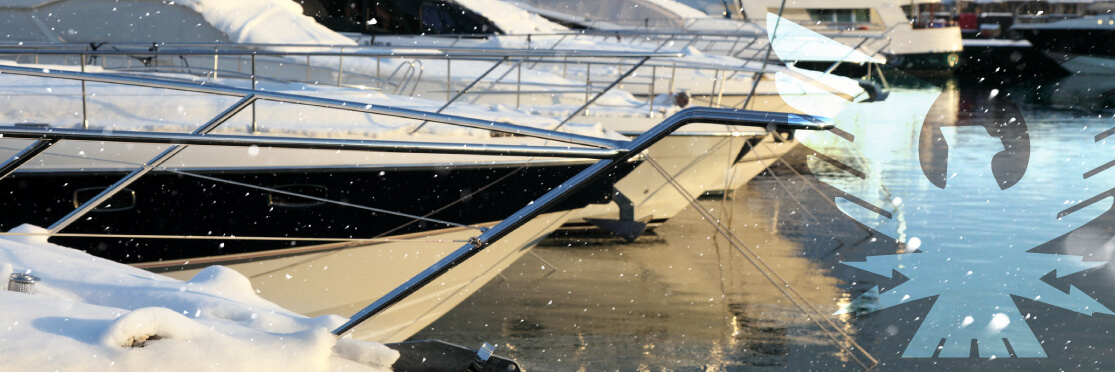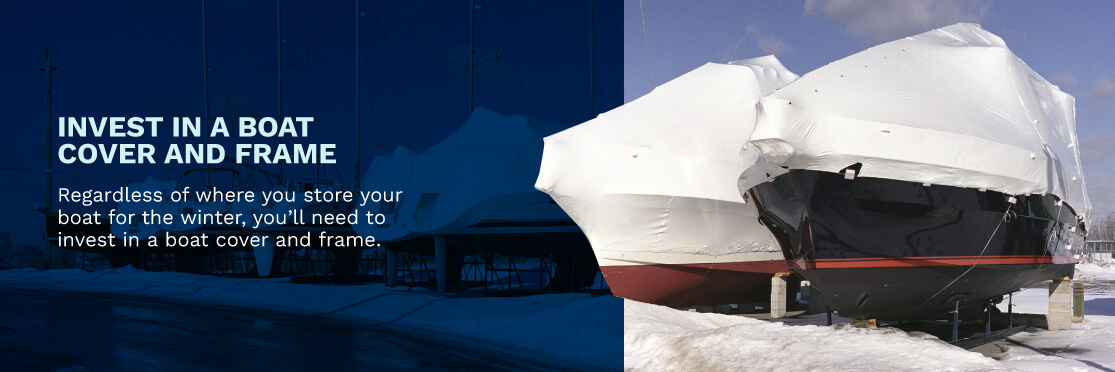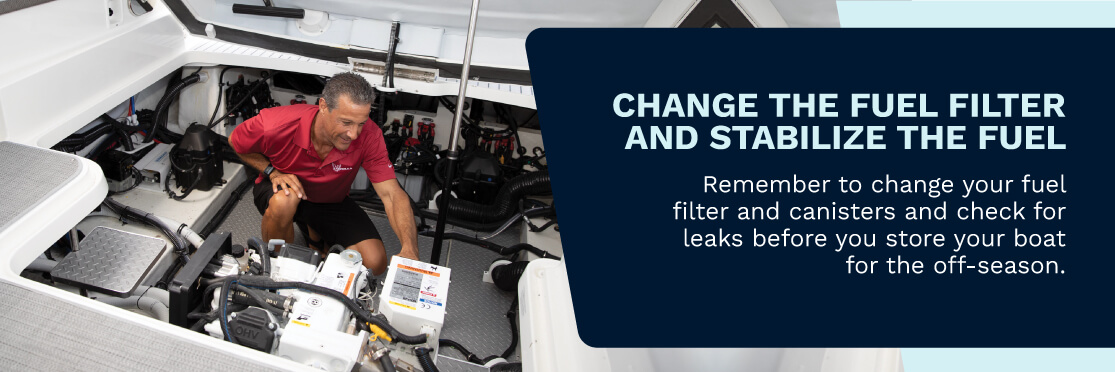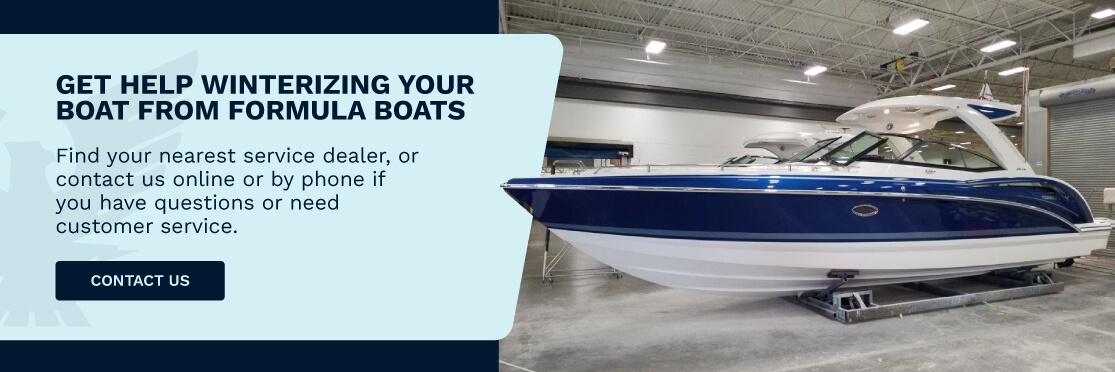
The fall chill is in the air, reminding many of us across the country that our boating days are wrapping up for the season. While it’s easy to shift your focus to fall activities and pack up your boat for the winter in a hurry, we’re here to remind you that to maximize the life of your boat — and to minimize the costs due to winter damage — you need to prep your boat for winter.
Preparing your boat for winter is also known as winterizing. Winterizing your boat can be time-consuming, and while you can winterize a boat yourself, you can also hire professionals to do it for you. If you do decide to hire a professional, it’s important to hash out the details beforehand. “Winterizing” doesn’t mean the same thing to everybody, so the best way to ensure you’re getting the service you expect is to have a written contract of what the company will do to prepare a boat for winter.
But for those of you who are interested in doing all or some of it yourself, we’ve compiled a list of tips for preparing your boat for winter.
The specific steps you’ll need to take to prep your boat for winter will depend on the type of boat you have, so it’s important to consult your owner’s manual, which should have a winterizing or storage section. The section will give you the best care for your boat in the off-season.
Overall, certain tips for preparing your boat for winter apply to all makes and models, but specifics vary depending on the type of boat and its features. We’ve done our best to make this a comprehensive list, calling out details when appropriate, so you know what winterizing looks like for your particular vessel.
1. Take Care of Any Required Maintenance in the Fall
When the weather starts to get warmer and spring fever is upon us, boat shops are in the midst of their busiest season — which means you’ll have longer wait times and a delay getting your boat back in the water. Instead, do your maintenance in the fall.
Use the process of winterizing your boat as an opportunity to thoroughly check and make sure everything is working well. Verify that the exterior and interior of the boat are in optimal condition. For example, when changing the oil, check for leaks and replace any worn or damaged parts.
If something is out of place or doesn’t seem to be running smoothly, fall is the best time to get it in for maintenance. It’s also a great time to get your routine maintenance done. After that, a thorough winterization means your boat is in its best shape and ready for the first sign of spring.
2. Determine Out-Of-Water or In-Water Storage
Ideally, you’d store your boat in a climate-controlled warehouse during the off-season, but for most, the price tag that accompanies that type of storage is next to impossible to afford. If you live in an area that doesn’t usually see temperatures near or below freezing in the winter, you may store your boat in the water or out of the water. Here are a few pros and cons of each storage option.
In-Water Storage
Here are the advantages of in-water storage:
- Immediate accessibility: When you keep your boat in the water, there’s no need to haul it to or from its in-season location.
- Less preparation: With in-water storage, you can skip some winterization and de-winterization steps, so it’s ready for use at the first sign of spring.
- Cost-effective: You save on transportation costs and possibly storage fees.
These are the main disadvantages:
- Increased risk of marine growth: Leaving your boat in the water makes it more susceptible to water scum and marine organism growth.
- Increased risk of sinking: Storing your vessel in the water increases the risk of a sunken boat. Be sure to check your boat frequently for leaks.
- Exposure to the elements: In the water, boats are more exposed to damage from storms, wind and freezing temperatures.
Out-Of-Water Storage
Here are the benefits of out-of-water storage:
- Reduced risk of blisters: Storing your boat “on the hard” reduces the risk of blisters on a fiberglass hull.
- Less vulnerable to weather: Even if it’s stored outside, keeping your boat out of the water offers more protection from a sudden freeze or storm.
- Easier to maintain: Pulling your boat out of the water makes it easier to clean and inspect the hull and complete maintenance tasks or necessary repairs.
These are the drawbacks:
- Transportation costs: Out-of-water storage generally requires additional hauling to and from the marina. Even if you can keep your boat on-site, you still need to remove it from the water.
- More preparation: You’ll likely need to do more prep work before being ready in spring if you take your boat out of the water.
Once you’ve decided how to store your boat, there are a few winterizing tips specific to each of these storage options. If you decide to store your boat out of the water, you want to clean all exterior surfaces thoroughly and open seacocks to drain water.
If you decide to store your boat in the water, your focus should be on ensuring all seacocks are closed, and that pumps and your battery are working together to turn on the boat when necessary to drain water. Checking for leaks is important for all boats, but especially for a boat that will be stored in the water, as a leak could lead to a sunken boat.
3. Invest in a Boat Cover and Frame
One of the reasons winter can be so harsh on your boat is exposure to the elements, including cold temperatures, snow, ice and rain. Regardless of where you store your boat for the winter, you should consider investing in a boat cover and frame.
The key to finding the best boat cover is fit. If you try to make a one-size-fits-all cover work, chances are you’ll end up with something that is either too big — which welcomes pooled water and can catch the wind — or too small, leaving areas of your boat exposed or stretching the cover.
If your owner’s manual or manufacturer doesn’t recommend a specific cover for your boat, there are plenty of places you can go to get a custom cover, which is sure to give you the best fit.
Frames are temporary structures you can assemble and put on top of your boat, underneath the cover. They are essential because they minimize the amount of snow, pooling water and debris on top of your boat. Any snow, water or debris that does manage to accumulate on your boat cover is evenly distributed by the support, decreasing the chance of damage to your boat due to unwelcome weight.

4. Change the Oil and Oil Filter
Inevitably, oil in your boat can get water and other contaminants in it over time. The composition of oil can change over time, becoming more acidic. When it sits for an extended period — like over the winter — the water and contaminants sit in the engine, which can cause expensive damage.
Changing the oil and oil filter right before you store your boat for the winter can save you from an expensive surprise when you uncover the boat next season. Don’t forget to let the engine run for a few minutes before you change the oil — that ensures any contaminants have a chance to become suspended in the oil before you change it, so you can minimize the contaminants that are left when you change the oil. The oil change is also a great time to check for any oil leaks.
5. Pressure Wash and Inspect Your Boat Bottom
Over time, barnacles, dirt and other water scum are bound to accumulate on the bottom of your boat. Before you store it for the season, dedicate time to scraping and sanding it all off. Follow the scraping and sanding with a thorough pressure wash. In the future, you can decrease the amount of scraping, sanding and scrubbing by applying a wax at the beginning of the season.
Once you’ve thoroughly cleaned the bottom of your boat, inspect it for cracks, blisters and dents. If you discover something minor, you may be able to fix it yourself with a filler or rubber mallet. If you discover something serious, have a professional look at it. Any cracks or blisters can become a nightmare with cold temperatures over the winter.
6. Change the Fuel Filter and Stabilize the Fuel
Remember to change your fuel filter and canisters and check for leaks before you store your boat for the off-season. Stabilizing fuel to prep your boat for winter ideally begins before your last day on the water.
Assuming your boat runs on gasoline and has ethanol in it, it’s at risk for something called phase separation, which occurs when the ethanol in the gasoline absorbs moisture to the point that it separates from the gasoline and causes damage to your engine. There’s no way to fully reverse phase separation, but you may be able to recondition the fuel. If that doesn’t work, you’ll have to drain the tank.
Your best-case scenario is to empty the fuel tank so absolutely nothing is in it. Since that’s often not practical, the next best thing is to stabilize the fuel.
There are a variety of stabilizers available — your manufacturer may recommend one. Whichever you choose, add it when you still have a few boating days left so it has time to completely and thoroughly circulate throughout the fuel system. Then, top off your tank to 95% full. With the fuel tank this full, there is less room for moisture to accumulate. Treat it with a fuel stabilizer again, and let the engine run for a bit to circulate. Now your fuel is prepped and ready for winter.

7. Use a Mildew Spray on Interior Surfaces
It’s always important to care for the interior of your boat, but this becomes especially important during the winter. While a strong boat cover and frame are perfect for protecting it from the elements, they can also be a trap for moisture.
Making sure your boat cover has a vent — many are available that connect right to the frame and cover — is a great step to reducing moisture. But to provide the ultimate protection for your interior, consider coating the interior of your boat with a mildew spray before applying the boat cover and storing it for the winter. This step can help save you from a major cleaning project in the spring.
8. Remove Electronics From the Interior
In addition to causing mildew, moisture can corrode your electronics, leading to shorts and blown fuses — two things that can be expensive to repair. Before you cover your boat for winter storage, remove any electronics you can and store them in an environment that’s protected from winter temperatures and moisture. For the electronics you can’t remove, spray exposed electrical connections with a moisture-displacing lubricant to help protect them from moisture.
9. Drain the Water From the Engine and Add Antifreeze
Whatever type of engine you have, draining and flushing the system with antifreeze is essential. However, the steps taken vary depending on the type of engine on your boat. We’ve listed an overview of the most common below, but it’s important to remember your owner’s manual will have the best, most specific information on winterizing your boat. Boat winterization kits can help you, regardless of the engine you have.
How to Winterize an Outboard Boat
To winterize an outboard engine, use flush muffs or the flushing port on the back of the engine. Start the engine, remove the cowl and spray fogging oil into the air intakes on the front of the engine to circulate throughout the system to prevent rust and corrosion.
Keep the engine running while you disconnect the fuel line from the engine, and continue to spray the fogging oil until the engine dies. This step ensures all fuel is burned and prevents buildup that can occur due to evaporating fuel.
Next, move on to the propeller — apply water-resistant grease to the propeller shaft and threads. Finally, lubricate or polish the engine exterior and wash it with soap and water, making sure you rinse it thoroughly.
How to Winterize an Inboard Boat
To winterize a boat with an inboard motor, use the water pump and intake hose. Dump antifreeze into a bucket, then stick one end of the intake hose into the bucket. Start the engine and let it run until the antifreeze exits the exhaust, assuring you it has circulated throughout the system. It’s also a good idea to change your transmission fluid, remove spark plugs and spray fogging oil into each cylinder to prevent rust and corrosion during the off-season.
How to Winterize a Stern Drive
Winterizing a stern drive begins with a thorough visual inspection of the lower section, removing any plant life or barnacles you find. Then, clean it with soap and water. Check for cracks or pinholes in the rubber boot between the transom and engine, if you have one. Finally, make sure to grease fittings and check your fluid levels in hydraulic steering or lift pumps.
10. Drain the Freshwater System and Add Antifreeze
Freezing water can be a nightmare for boat owners. While draining your freshwater system is a start, the reality is that water can linger in areas throughout the system — and it doesn’t take much water to freeze and cause a disaster in the form of cracked pipes, valves and pumps. So, in addition to draining every part of your freshwater system, circulate antifreeze throughout to ensure freezing will not occur.
Start with shutting off your dockside hookup and draining the hose. Open all outlets to drain water, then close them. Pour antifreeze into the tank and reopen the outlets until you see antifreeze come out to ensure it’s throughout your freshwater system. Be sure to use nontoxic antifreeze, especially if you use any of the freshwater for drinking or cooking.
11. Disinfect the Marine Head and Add Antifreeze
Marine heads come in all shapes and sizes — with and without holding tanks and as part of a sanitation system. While the method may differ for each, the bottom line is the same — you’ll need to disinfect and add antifreeze.
If your toilet doesn’t have a holding tank, simply pour disinfectant into the bowl and pump it throughout the system, followed by antifreeze. If you have a holding tank, make sure you empty it before you pump disinfectant and antifreeze through the tank and the “Y” valve, if you have one.
Marine sanitation systems can be tricky, and winterizing techniques vary, so for the best advice, consult your owner’s manual.
12. Remove Oil and Water From Bilges
Over the course of a boating season, bilges can collect oil and water. It’s important to clean any oil spills thoroughly. Even if the amount of oil is small, give the bilge a meticulous cleaning. Then, add a moisture-displacing lubricant to deter the accumulation of moisture during the winter. Finally, add a bit of antifreeze to ensure any water that may collect over the winter months will not freeze and cause damage to your boat.
Frequently Asked Questions
To recap, here are some brief answers to the most common questions about winterizing a boat:
What Is Required to Winterize a Boat?
To winterize a boat, you need:
- Antifreeze
- Fogging oil
- A boat cover
- Mildew spray
- Cleaning supplies
- A scraper and sandpaper
- New oil and a new oil filter
- A new fuel/water separator
- Moisture-displacing lubricant
- Fuel stabilizer and a new fuel filter
How Do You Winterize a Boat With Antifreeze?
To winterize your boat, you need to put antifreeze in the engine, freshwater system, marine head and sanitation system. Specific instructions vary depending on the type of engine and head you have. You’ll want to clear out any water and replace it with antifreeze, especially if you’re storing your boat outdoors in a climate with freezing temperatures.
When You Winterize a Boat, Do You Leave the Antifreeze in It?
After adding antifreeze to your boat, leave it in all winter to prevent water from freezing in your engine or water systems and damaging your vessel. Leaving antifreeze in these systems also protects the components from rust since there won’t be air pockets where water can condense. You’ll flush the antifreeze in the spring when you de-winterize your boat.
Can I Leave Gas in My Boat Over the Winter?
While it’s best to empty your fuel tank if it’s practical, you can leave gas in your boat over the winter. However, you should add a fuel stabilizer to prevent phase separation and fill the tank mostly full to avoid condensation in the tank. You should also change the fuel filter and the fuel/water separator before storing your boat.
Get Help Winterizing Your Boat From Formula Boats
Prepping your boat for winter involves several steps. Forgoing or improperly completing a step could result in expensive repairs. While this guide provides insight on how to winterize a boat, the ultimate guide is your owner’s manual. It’s always best to consult that resource for specific tips on preparing your boat for winter.
Alternatively, you could look for a boat professional near you to handle boat winterization. If you have a vessel from Formula Boats, you can leverage our network of over 125 service providers to help you maintain and winterize your vessel. Find your nearest service dealer, or contact us online or by phone if you have questions or need customer service.

